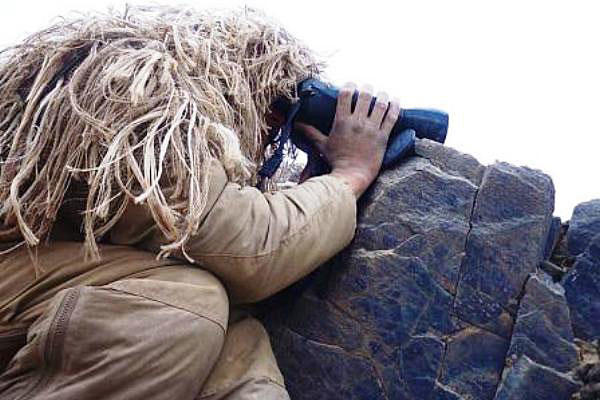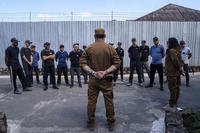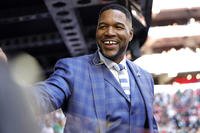CAMP LEJEUNE, North Carolina -- Part of the Marine Corps' special operations force is attempting a better way to support combatant commanders by eliminating burdensome layers in the chain of command.
The first Marines taking part in the "Force Recon Detachment Concept" are deploying with the 24th Marine Expeditionary Unit, with the hope that the change helps the elite force do more with less as hot spots pop up around the globe even as the defense budget shrinks.
Previously, one of the two deployed Recon platoons reported to the lower-level Battalion Landing Team commander instead of the MEU commander, which resulted in poor training because of a lack of understanding at the battalion level of what it took to keep Recon proficient. Recon platoons also found themselves underutilized because tasking authorities had to go through two separate commands to get them involved.
"Now the Force Recon Detachment Concept gives the MEU commander two maneuver assets," said Master Sgt. Cory Paskvan of the Second Reconnaissance Battalion, based at Camp Lejeune. Paskvan explained that concept is comprised of two Force Recon platoons trained to "light capability" -- missions like ship takedowns, precision raids and surveillance -- that now fall directly under the MEU's command element. Planners hope a more direct tasking line results in better training and missions tailored to the full extent of Force Recon's capabilities.
Change is nothing new to Marine Corps Reconnaissance units. Since the earliest days of Recon -- the raider and scout missions of the island-hopping campaign in the Pacific Theater during World War II -- the elite warriors have adopted new techniques to accomplish the mission wherever it took them and adapted to whatever Headquarters Marine Corps or the Pentagon demanded of them in terms of force structure or mission focus.
Recon grew in the wake of 9/11 as the need for its unique capability increased with the asymmetric wars in Afghanistan and Iraq. Then in 2006, the community was faced with what could be considered its biggest structural challenge to date when headquarters decided the Marines needed a Special Operations Command presence and MARSOC was created.
MARSOC took four platoons and the whole Recon command structure from Force Recon, the part normally tasked by the Marine Expeditionary Force commander for high-level missions. MARSOC originally deployed with the MEU with MEU support but reported to the theater special operations command. That setup caused resentment in that Marines had the burden of supporting MARSOC units without the ability to assign them missions.
After two deployment cycles, the Marine Corps had had enough. "They pushed them off the boats," Paskvan said.
In 2008, the Marine Corps reconstituted Force Recon companies. Force Recon units work for the MEF. Other Recon units work for the Division and are tasked by BLT commander. Force Recon units take higher profile missions and are made up of more senior guys who have two or three deployments with regular Recon units under their belts.
Like the Recon force in which he serves, Paskvan's own career has been a study in change. The first time he attempted to go Recon after finishing the School of Infantry, he didn't meet all of the the screening qualifications. He did one deployment as regular infantry but made it a point to network with the attached Recon guys during that time. As soon as he returned to their stateside base in Hawaii as a lance corporal, he reapplied for Recon.
About 20 Marines showed up for the one-day recon physical screening, which was a grueling series of events that included a swim test, a forced march around the perimeter of the base and up a mountain wearing a rucksack loaded with 50 pounds of gear, a run on the beach, and back-to-back timed runs of the obstacle course.
"Most guys cracked in the pool," Paskvan recounted. "By the end of the screener, only five of the 20 were left."
Paskvan went on to the Reconnaissance Indoctrination Program and learned advanced land navigation, patrolling, supporting arms and amphibious Recon missions. Along the way to becoming a fully mission-ready Recon Marine (with a 0321 military occupational specialty code), he got proficient in parachuting (including freefall), diving and sniping.
But Paskvan's pipeline from standard infantry to Recon doesn't exist anymore.
"You used to be able to get a 0321 qual with OJT at the unit level after successfully completing the Recon Indoc Program, but the Marine Corps but did away with that once Recon was made a primary MOS around 2001," Paskvan said. "Regardless of your MOS -- motor T, logistics or whatever -- you could go through RIP and become Recon."
Recon indoc taught Marines graduate-level skills around land nav, advanced patrolling, supporting arms, amphibious recon missions, and movement to contact.
Now those desiring to become Recon from a non-infantry MOS have to go through the School of Infantry first to get a 0311 (infantry) MOS and then go through the Basic Reconnaissance Course. This process was created to relieve units of the burden of running a RIP program as well as housing the guys who fell out of the program -- something they were never staffed for. The new pipeline also had the desired effect of standardizing Recon training across the force.
Getting trained is one challenge. Staying trained is another.
Paskvan explained that Second Recon's Bravo Company just finished a Special Purpose MAGTF Crisis Response deployment, based in Spain to work contingency operations around Africa. They got back, had some down time, transferred gear from the MEU to the battalion, and now they're starting to train again to support the next MEU or whatever tasking comes their way.
The Recon training and readiness matrix is complicated and intense. For example, to maintain a jump qualification, a Marine must jump at least once every three months. Those qualified as "Category 3 Freefallers" have to perform their jumps in full combat gear while wearing oxygen and carrying a weapon at night. Snipers have to train in all light conditions. Dive quals have to be updated.
Most of the required training takes place around Camp Lejeune, which has extensive training range complexes. Air support comes from fixed-wing assets stationed at Marine Corps Air Station Cherry Point to the north and rotary wing assets (including the tiltrotor V-22) just to the south at MCAS New River.
Paskvan knows firsthand that the training isn't just about checking blocks for some matrix that only the admin types at headquarters care about. The training has to be high quality because any one or all of those skills will be used during the next deployment.
He recounted how training was comprehensively challenged in the Iraq War during 2005-2006 when Recon units actually "owned battle space," something usually assigned to regular infantry units that Recon supports. This doctrinal change was a function of the volatility of the region around Fallujah and the fact that the Marine Corps was stretched thin during that period.
Infantry squads' effectiveness in Iraq, he said, was by-in-large a function of what they came across during their patrols. "Infantry wants to go out and crush stuff," Paskvan said. "They're a large footprint."
Recon, on the other hand, took a longer approach to the problem, scoping out bad guys sending rockets into forward operating bases or setting IEDs along major routes. Once ID'd, Recon would snipe them or call in close air support to "neutralize the threat."
Regardless of the chaos in Iraq these days, Paskvan can say that the efforts of Marine Recon in Fallujah in 2006 made a difference in the years that followed.
"I went back in '07," he said. "Things were quiet, boring even. I'd like to think Recon did good."




























